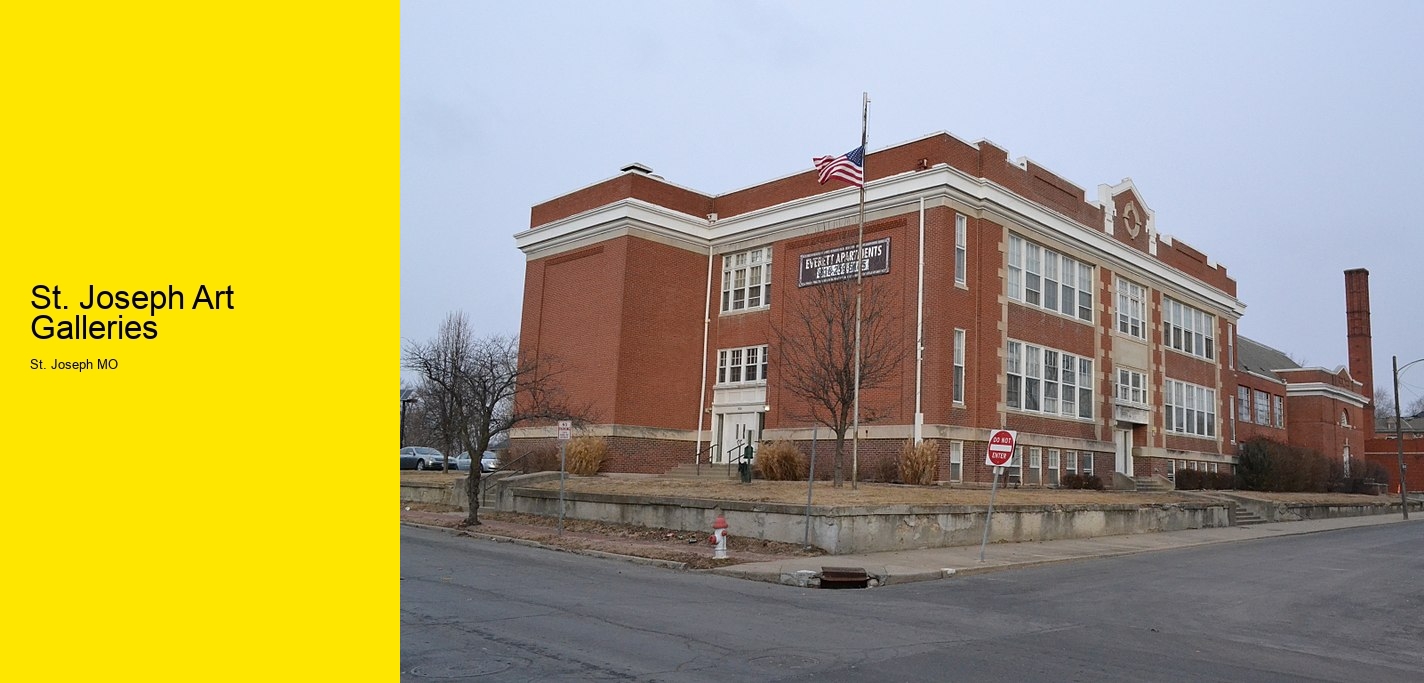St Joseph Art Galleries: The Local Art Venue Showcases A Diverse Collection Of Contemporary And Traditional Works
Exploring the vibrant world of artistic expression in the heart of St. Joseph can be daunting. Many enthusiasts frequently grapple with the overwhelming variety of styles, mediums, and themes, which can leave one feeling lost.
St. Joseph Art Galleries - Jesse James
- steamboat
Fortunately, the local art establishments excel in addressing these common concerns.
St. Joseph Art Galleries - Jesse James
- Kansas City metropolitan area
- Kansas City International Airport
- Diverse Collections: A rich tapestry of artwork from local talents and beyond, showcasing everything from contemporary pieces to classic works.
- Engaging Events: Regular exhibitions and workshops that foster community interaction and provide opportunities for hands-on experiences.
- Knowledgeable Staff: Enthusiastic guides ready to share insights and narratives behind each piece, enhancing the appreciation of the artwork.
- Accessible Spaces: Galleries designed to be welcoming, with thoughtful layouts that encourage leisurely exploration without feeling rushed.
As someone who has wandered through these artistic havens, I can attest to the joy they bring. The welcoming ambiance and the attentive staff made every visit a delightful journey, promising not just visual feasts but also enriching dialogues about creativity and inspiration. Whether you are on a quest for that perfect piece or simply wish to immerse yourself in culture, these local treasures truly cater to every desire and curiosity.
Exploring the Art Landscape in St. Joseph MO
The rich tapestry of creativity woven throughout St. Joseph has evolved remarkably over the decades. From humble beginnings, the artistic community has flourished, transforming the region into a vibrant hub for creators and admirers alike. The transition from traditional forms to contemporary expressions showcases the dynamic nature of local talent.
Local artists have tirelessly contributed to the cultural fabric, establishing a unique identity that resonates with both residents and visitors. This evolution reflects a broader movement, one where innovation and tradition coalesce to form a distinctive artistic voice.
Understanding the intricacies of this artistic growth is essential for those looking to immerse themselves in the local scene. Here are some key elements that define the art narrative in this area:
- Community Engagement: Collaborative projects foster connections among artists and the public, enhancing appreciation for diverse art forms.
- Historic Venues: Older buildings repurposed as galleries provide a backdrop that enriches the viewing experience, marrying history with modern artistry.
- Art Education: Workshops and classes led by seasoned artists encourage budding talent, ensuring the continuation of creative traditions.
They seamlessly integrate these elements, crafting an environment where creativity thrives. The dedication to promoting local artists and their work is evident in every exhibition and event. This nurturing atmosphere allows for experimentation and exploration, giving rise to innovative ideas and stunning creations.
To fully appreciate the artistic journey within St. Joseph, consider engaging with the community. Attend gallery openings, participate in local art fairs, and explore workshops that spark inspiration. Each experience adds a layer of understanding to the vibrant narrative unfolding in this artistic enclave.
Notable Exhibitions and Events in Local Art Spaces in St. Joseph MO
The vibrant art scene in St. Joseph, Missouri, is a tapestry woven with creativity and culture, showcasing an array of exhibits that captivate the senses. Artists from diverse backgrounds converge to illuminate their visions, creating a rich dialogue between the creator and the observer. Among the most celebrated occurrences are the seasonal showcases that highlight local talent, often drawing enthusiastic crowds eager to explore fresh perspectives.
Highlights often include:
- Interactive installations that invite viewer participation.
- Themed showcases that rotate monthly, ensuring a constant influx of new works.
- Collaborative projects that unite artists from various disciplines, enriching the community's creative fabric.
What sets these exhibitions apart is the meticulous curation, which not only emphasizes aesthetic appeal but also engages with pressing societal narratives. This thoughtful approach encourages dialogue and reflection, transforming the gallery into a forum for discussion.
Insider Tip: Attend opening receptions for a unique chance to meet the artists and gain firsthand insights into their inspirations. Be on the lookout for upcoming workshops that provide hands-on experience and foster artistic skills among attendees. Networking opportunities abound, as many local artists also host informal gatherings post-exhibit to discuss their works in a relaxed setting.
The energy in these venues is palpable, making each visit an experience rather than just an observation. Don't miss out on the chance to immerse yourself in the local arts community, where creativity knows no bounds.

Artistic Expressions in St. Joseph, MO
The diverse array of artistic styles showcased in this vibrant locale offers a feast for the senses. From contemporary pieces that push boundaries to classic works that evoke nostalgia, the galleries present a rich tapestry of creativity.
St. Joseph Art Galleries - steamboat
- Jesse James
- Abstract Art: Pieces that convey emotions through shapes and colors, often leaving interpretation to the viewer.
- Realism: Art that mirrors the world with striking accuracy, capturing everyday life in stunning detail.
- Mixed Media: Innovative combinations of various materials, creating multi-dimensional experiences that engage the audience.
- Sculpture: Three-dimensional works crafted from diverse materials, adding tangible depth to the artistic experience.
Each gallery's commitment to representing an eclectic range of styles ensures that every visitor finds something that resonates. The establishments understand the intricacies of art appreciation and curate exhibits that cater to varying tastes and preferences.
Exploring the local art scene reveals more than just visual enjoyment; it opens doors to cultural dialogues and community engagement. Lesser-known artists often find a platform here, allowing emerging talents to shine alongside established creators.
For those looking to deepen their understanding of art, consider these tips:
- Engage with the Art: Spend time with each piece; allow its nuances to unfold.
- Attend Workshops: Many galleries offer sessions led by artists, providing insights into their creative processes.
- Network: Connect with fellow art enthusiasts to share thoughts and perspectives on various works.
This community thrives on creativity, and the galleries play a pivotal role in fostering artistic growth and appreciation. By showcasing an extensive collection of artistic expressions, they contribute significantly to the cultural fabric of St. Joseph, MO.
Engaging the Community Through Art Education in St. Joseph MO
Artistic expression often encounters obstacles, particularly when it comes to accessibility and involvement in local enterprises. Barriers to entry can stem from a lack of resources or opportunities for individuals to connect with their creative side. This is where the local art destination shines, fostering an environment that nurtures creativity and community spirit.
The establishment recognizes the importance of fostering connections between residents and the arts, offering a variety of programs tailored to diverse audiences. Their initiatives not only enhance appreciation for the arts but also empower individuals to explore their artistic inclinations, regardless of prior experience.
- Workshops tailored for all ages, covering various mediums such as painting, sculpture, and photography.
- Collaborative projects that unite community members in creating large-scale public art pieces.
- Educational seminars led by seasoned artists that delve into techniques and art history.
Through these innovative programs, the venue effectively nurtures a love for creativity, while also addressing the need for inclusive art education. An insightful approach includes integrating local culture into the curriculum, allowing participants to draw inspiration from their surroundings.
Tips for Maximizing Community Engagement
- Encourage participation by offering free introductory classes to attract newcomers.
- Utilize social media to showcase local artists and their contributions to the community.
- Host regular events that invite families to experience art together, creating lasting memories.
By cultivating these opportunities, this remarkable institution stands at the forefront of community engagement, enriching lives and inspiring creativity across St. Joseph MO.
Exploring the Creative Scene in St. Joseph, MO
Artists in this vibrant city often navigate a myriad of hurdles, from securing exhibition opportunities to obtaining the right materials. The local art scene is teeming with talent, yet many creatives face obstacles that can stifle their artistic expression. Fortunately, the community has a strong network of venues dedicated to uplifting these artists.
Local galleries are not just spaces to display art; they serve as incubators for innovative ideas and collaboration. These spaces provide a platform for both emerging and established artists, fostering an environment where creativity flourishes. Within the walls of these galleries, one can discover:
- Diverse mediums, from traditional painting to cutting-edge digital works.
- Regular workshops that encourage skill development and creative exploration.
- Networking events where artists can connect and share insights.
Notably, the presence of accomplished artists in St. Joseph enriches the cultural tapestry of the area. Their unique perspectives often draw inspiration from local history and the natural beauty surrounding them, resulting in artwork that resonates deeply with the community. Engaging with these artists can offer valuable insights into their creative processes.
For those looking to enhance their artistic journey, consider these expert tips:
- Visit galleries during opening receptions to meet artists and discuss their techniques.
- Participate in local art fairs to gain exposure and receive feedback.
- Explore collaborations with other artists to expand your creative horizons.
Embracing the local art scene not only enriches your own practice but helps cultivate a vibrant community that supports artistic endeavors at every level. This dynamic environment allows artists to thrive amidst the ever-evolving landscape of creativity.
The Economic Impact of Art Galleries in St. Joseph MO
Art institutions serve as vital cogs in the economic machinery of communities, particularly in regions like St. Joseph. They attract tourism, stimulate local economies, and create unique cultural hubs. A significant aspect often overlooked is how these artistic spaces enhance property values in their vicinity, establishing a ripple effect that benefits local businesses.
Artists and curators often wrestle with limited visibility and exposure, which can hinder their potential for growth. Local galleries are adept at addressing these hurdles by providing platforms where creators can showcase their work, thus fostering a vibrant arts scene. This initiative not only enriches the cultural landscape but also directly contributes to financial sustainability in the area.
- Galleries often collaborate with local businesses, leading to cross-promotion that boosts foot traffic.
- Exhibits can serve as catalysts for events that draw large crowds, benefiting nearby restaurants and shops.
- Art education programs foster community engagement, attracting families and students, which further stimulates economic activity.
Engagement with the arts has been shown to increase community pride, resulting in a more robust local identity. These institutions are key players in weaving a rich tapestry of cultural experiences that not only entertain but also educate. They play a crucial role in nurturing talent, providing mentorship opportunities that can propel artists into broader markets.
Incorporating interactive exhibits can also heighten visitor engagement, leading to longer stays and higher spending in the area. Emphasizing local artists in exhibitions can cultivate a sense of ownership among residents, thereby fostering a supportive environment for creativity and innovation.
I couldn't be more pleased with my experience at St. Joseph Art Galleries! The knowledgeable staff provided exceptional guidance and support, helping me discover the perfect pieces for my collection. If you're looking for expert advice or simply want to explore the incredible art on display, I highly recommend reaching out to them for a free consultation. Don't miss the chance to enhance your artistic journey with their valuable insights!




















